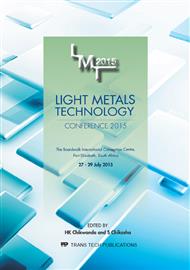p.62
p.69
p.73
p.78
p.82
p.87
p.93
p.100
p.106
Melt Refining Technology of Highly-Contaminated Magnesium Alloy Scraps via a Sequential Refining Process
Abstract:
Steering wheel and headlamp housing scrap are chosen as targets for the development of a refining technology for highly contaminated magnesium melt, because they contain abundant foreign materials, which have high potential to form non-metallic inclusions and to deteriorate the corrosion resistance of recycled alloys. A sequential melt treatment technology has been investigated for refining old scrap. The headlamp housing scrap composed of AZ91D magnesium alloy covered with phosphating and Al-Si deposition layers was successfully refined by repeating gas bubbling without flux addition, whereas prefiltering and fluxing were necessary to refine the steering wheel scrap composed of AM50A magnesium alloy containing 1% polyurethane. However, the corrosion rates of the recovered ingots from the headlamp housing were relatively higher than those from the steering wheel, likely due to the greater concentration of iron with the increased amount of flux.
Info:
Periodical:
Pages:
82-86
Citation:
Online since:
August 2015
Authors:
Keywords:
Price:
Сopyright:
© 2015 Trans Tech Publications Ltd. All Rights Reserved
Share:
Citation:


